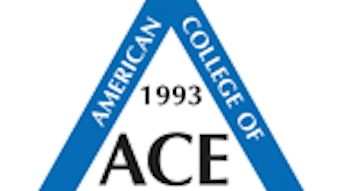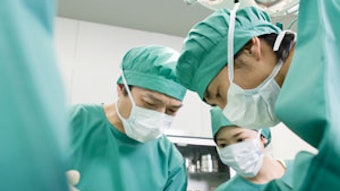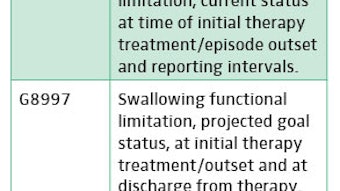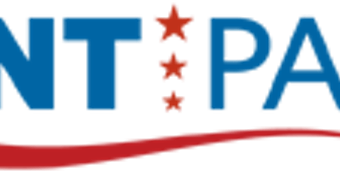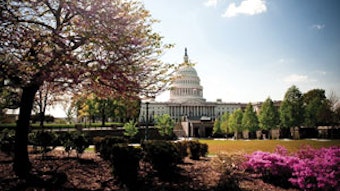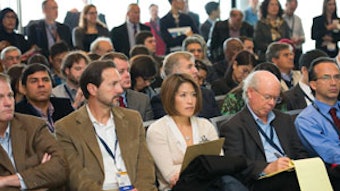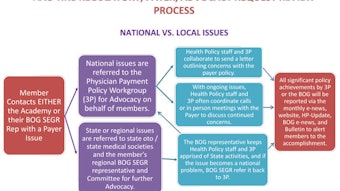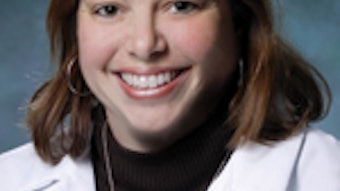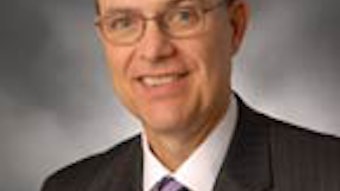Otolaryngology in Kenya
Robert T. Standring, MD Resident, Henry Ford Health System Humanitarian Travel Grant Awardee (September 13–23, 2013) It was 4:30 am on a crisp morning in a rural town of Kenya called Migori. The sun was starting to make its way out to paint the beautiful tropical landscape. I was riding in a 30-year-old pickup-truck-turned-ambulance, rushing a patient from our makeshift surgery center to one of the local hospitals. Tamer Ghanem, MD, and I had just finished taking this post-op thyroid patient back to the operating room in the middle of the night to evaluate for a tracheal tear. She had undergone a hemi-thyroidectomy for a large substernal goiter the previous night and in our post-operative recovery room started to desaturate, had neck crepitus, and her drain would not hold suction. We suspected tracheal tear versus a pneumothorax and immediately took her back to the OR for exploration. During the surgery, we worked quickly and efficiently, but were slowed by multiple power outages and numerous massive flying bugs that “dive-bombed” our surgical field. We found no tracheal tear and later confirmed our other suspected diagnosis of a pneumothorax from a chest X-ray at the local hospital. Riding in the ambulance with the early-morning African air cooling my sweat-soaked scrubs, I had 20 minutes to reflect on what a whirlwind the past three days had been. After 80 surgeries and 690 patient visits in this small African village, my worldview and idea of medicine was forever changed. Kenya Relief is a faith-based, non-profit organization that sends 16 surgical and religious teams from around the United States to Migori to offer medical and surgical services. Our group consisted of seven surgeons, two primary care physicians, and an audiologist. Six CRNAs, six nurses and scrub techs, one pharmacist, one non-medical personnel, and a journalist accompanied us on our trip. The surgeons included three ENT attendings from Henry Ford Health System with subspecialization in facial plastics, head and neck, and neurotology. There was a pediatric general surgeon and a general surgeon as well as two ENT residents. This team from Henry Ford Health System was the largest and most specialized group to ever travel to the Kenya Relief campus in Migori. Syed Ahsan, MD, Tamer Ghanem, MD, and Lamont R. Jones, MD, supervised us. The 80 patients who underwent surgery consisted of 28 thyroidectomies, 10 otologic surgeries, seven midface/cleft palate/mandible procedures, six superficial face/scalp lesions, and 29 general surgery cases. The otologic surgeries were the first that had been performed at Kenya Relief. There were two cases that required patient hospitalization post-operatively. After flying to Nairobi, we took a six-hour van ride to Migori. During our first day we toured the campus and spent time with the orphans. They put on an amazing native dance performance for us. We then surveyed the clinic that we made into our surgery center and set up all of our trays and equipment. The night prior to the first operating day, physicians met with patients waiting at the clinic to begin triaging patients based on severity of health problems and surgical complexities. Full histories and physicals were performed, written informed consent was obtained on all patients requiring surgery, and the site of surgery was marked during the initial evaluation. Two family medicine physicians and the surgeons performed the pre-screening process. All thyroid patients were placed in order of severity of clinical symptoms and size. Otology patients were placed in a separate clinic to be assessed by the neurotologist and an audiologist for evaluation and hearing exam. The amount we were able to accomplish and the difference we made in such a little amount of time was astounding. Yet, despite the fact we saw so many people and changed so many lives, there were huge groups of people that we had to turn away due to a lack of time and supplies. We brought more than 30 crates of supplies and operated until we ran out and could no longer perform surgeries. We would have wanted to perform total thyroidectomies on patients, but chose to do only hemi-thyroidectomies due to the lack of access to thyroid hormone replacement. In the future, it would be beneficial to bring a large supply with us to distribute to the Kenyans. The team plans to return every year with residents and staff, keeping continuity of care for the patients and surrounding communities. This mission trip was a once-in-a-lifetime experience that has positively changed my view on the world and how I practice medicine. I would like to thank the AAO-HNSF Humanitarian Efforts Committee for helping me participate in this experience.
Robert T. Standring, MD
Resident, Henry Ford Health System
Humanitarian Travel Grant Awardee
(September 13–23, 2013)
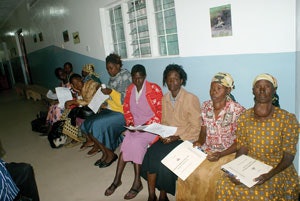 Kenya Relief group. Dr. Standring is fourth from the left in the back row.
Kenya Relief group. Dr. Standring is fourth from the left in the back row.It was 4:30 am on a crisp morning in a rural town of Kenya called Migori. The sun was starting to make its way out to paint the beautiful tropical landscape. I was riding in a 30-year-old pickup-truck-turned-ambulance, rushing a patient from our makeshift surgery center to one of the local hospitals. Tamer Ghanem, MD, and I had just finished taking this post-op thyroid patient back to the operating room in the middle of the night to evaluate for a tracheal tear. She had undergone a hemi-thyroidectomy for a large substernal goiter the previous night and in our post-operative recovery room started to desaturate, had neck crepitus, and her drain would not hold suction. We suspected tracheal tear versus a pneumothorax and immediately took her back to the OR for exploration. During the surgery, we worked quickly and efficiently, but were slowed by multiple power outages and numerous massive flying bugs that “dive-bombed” our surgical field. We found no tracheal tear and later confirmed our other suspected diagnosis of a pneumothorax from a chest X-ray at the local hospital.
 Women with goiters line up prior to surgery.
Women with goiters line up prior to surgery.Riding in the ambulance with the early-morning African air cooling my sweat-soaked scrubs, I had 20 minutes to reflect on what a whirlwind the past three days had been. After 80 surgeries and 690 patient visits in this small African village, my worldview and idea of medicine was forever changed.
Kenya Relief is a faith-based, non-profit organization that sends 16 surgical and religious teams from around the United States to Migori to offer medical and surgical services. Our group consisted of seven surgeons, two primary care physicians, and an audiologist. Six CRNAs, six nurses and scrub techs, one pharmacist, one non-medical personnel, and a journalist accompanied us on our trip. The surgeons included three ENT attendings from Henry Ford Health System with subspecialization in facial plastics, head and neck, and neurotology. There was a pediatric general surgeon and a general surgeon as well as two ENT residents. This team from Henry Ford Health System was the largest and most specialized group to ever travel to the Kenya Relief campus in Migori. Syed Ahsan, MD, Tamer Ghanem, MD, and Lamont R. Jones, MD, supervised us.
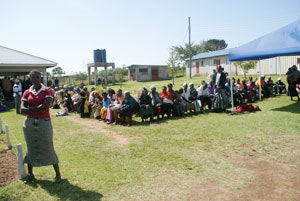 Patients wait outside the surgery center to be evaluated.
Patients wait outside the surgery center to be evaluated.The 80 patients who underwent surgery consisted of 28 thyroidectomies, 10 otologic surgeries, seven midface/cleft palate/mandible procedures, six superficial face/scalp lesions, and 29 general surgery cases. The otologic surgeries were the first that had been performed at Kenya Relief. There were two cases that required patient hospitalization post-operatively.
After flying to Nairobi, we took a six-hour van ride to Migori. During our first day we toured the campus and spent time with the orphans. They put on an amazing native dance performance for us. We then surveyed the clinic that we made into our surgery center and set up all of our trays and equipment. The night prior to the first operating day, physicians met with patients waiting at the clinic to begin triaging patients based on severity of health problems and surgical complexities. Full histories and physicals were performed, written informed consent was obtained on all patients requiring surgery, and the site of surgery was marked during the initial evaluation. Two family medicine physicians and the surgeons performed the pre-screening process. All thyroid patients were placed in order of severity of clinical symptoms and size. Otology patients were placed in a separate clinic to be assessed by the neurotologist and an audiologist for evaluation and hearing exam.
The amount we were able to accomplish and the difference we made in such a little amount of time was astounding. Yet, despite the fact we saw so many people and changed so many lives, there were huge groups of people that we had to turn away due to a lack of time and supplies. We brought more than 30 crates of supplies and operated until we ran out and could no longer perform surgeries. We would have wanted to perform total thyroidectomies on patients, but chose to do only hemi-thyroidectomies due to the lack of access to thyroid hormone replacement. In the future, it would be beneficial to bring a large supply with us to distribute to the Kenyans. The team plans to return every year with residents and staff, keeping continuity of care for the patients and surrounding communities. This mission trip was a once-in-a-lifetime experience that has positively changed my view on the world and how I practice medicine.
I would like to thank the AAO-HNSF Humanitarian Efforts Committee for helping me participate in this experience.
